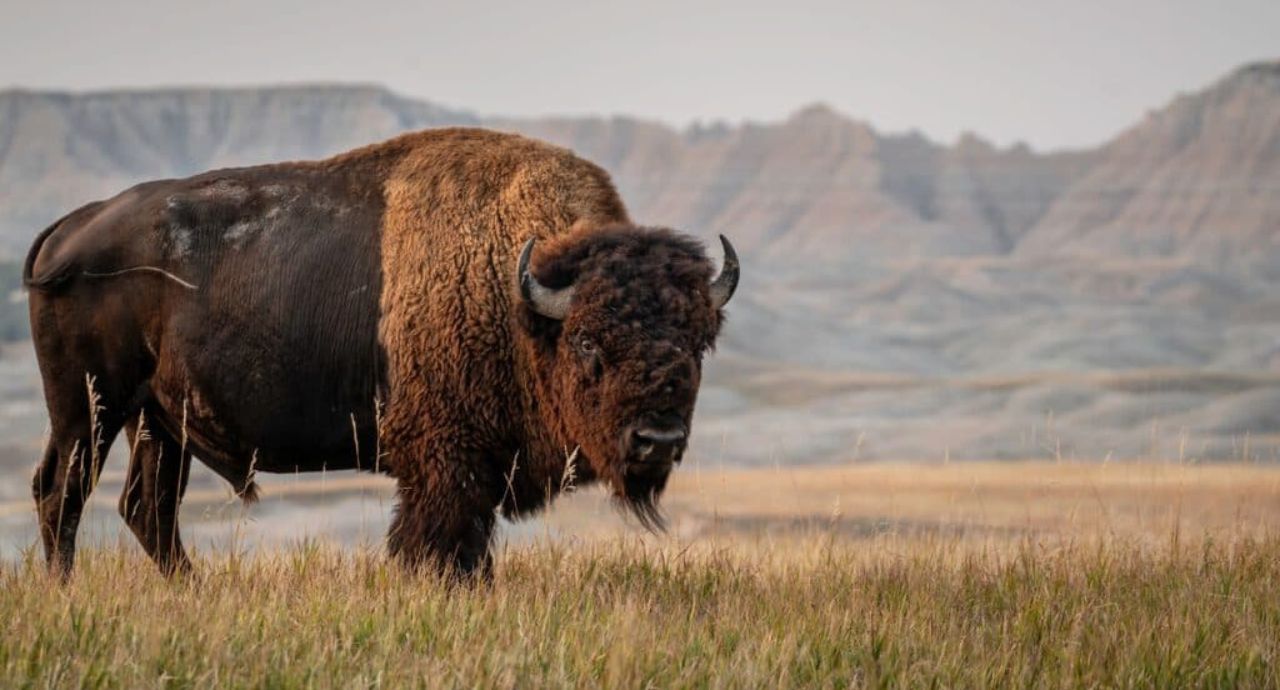America is home to a rich variety of wildlife, spanning from the dense forests and mountains to vast plains, deserts, and coastal regions. Here are some of the most iconic animals found across the country:
1. American Bison
- Habitat: Grasslands, plains, and prairies (especially in places like Yellowstone National Park).
- Description: The largest land mammal in North America, bison are massive, with thick, shaggy coats and powerful, muscular bodies. They were once nearly hunted to extinction but have since made a remarkable recovery.
- Interesting Fact: Bison can run up to 35 mph despite their large size and are known for their majestic herds roaming the plains.
2. Bald Eagle
- Habitat: Lakes, rivers, and coastal regions across the United States.
- Description: The national bird and symbol of the United States, the bald eagle is a large bird of prey with a striking white head and tail, contrasting with its dark brown body.
- Interesting Fact: Bald eagles are known for their powerful talons and impressive wingspan, which can reach up to 7.5 feet.
3. American Alligator
- Habitat: Wetlands, swamps, rivers, and lakes in the southeastern U.S.
- Description: A large reptile with a powerful, muscular body and a broad, rounded snout, the American alligator can often be seen basking in the sun near water.
- Interesting Fact: Alligators are a key part of the ecosystem in the southeastern U.S. and are known for their powerful bite and ability to thrive in both freshwater and brackish environments.
4. Grizzly Bear
- Habitat: Forests, mountains, and tundra in the western U.S. (primarily in Alaska, Montana, and Wyoming).
- Description: A subspecies of the brown bear, grizzlies are known for their distinctive hump on their shoulders, long claws, and immense strength.
- Interesting Fact: Grizzlies are omnivores, eating anything from berries and roots to large mammals like deer, and they can weigh up to 1,500 pounds.
5. Gray Wolf
- Habitat: Forests, tundra, and grasslands in the northern U.S., with significant populations in the Great Lakes region, the northern Rockies, and Alaska.
- Description: Gray wolves are highly social animals that live in packs, known for their strength, intelligence, and teamwork while hunting.
- Interesting Fact: Wolves are apex predators and play a crucial role in maintaining the balance of their ecosystems, especially in regions like Yellowstone National Park.
6. Mountain Lion (Cougar, Puma)
- Habitat: Wide range including mountains, forests, deserts, and swamps throughout the western U.S. and parts of Florida.
- Description: Mountain lions are large, solitary cats with tawny coats, known for their stealth and agility. They are also incredibly adaptable, living in a variety of environments.
- Interesting Fact: Cougars can leap up to 40 feet in a single bound and are extremely elusive, often avoiding human contact.
7. American Beaver
- Habitat: Rivers, streams, and lakes across much of North America.
- Description: Known for their dam-building capabilities, beavers are large rodents with flat tails and strong teeth designed to chew through wood.
- Interesting Fact: Beavers create intricate dams and lodges in rivers and streams, significantly altering their environment to create new habitats.
8. Pronghorn
- Habitat: Grasslands, deserts, and open plains in the western U.S.
- Description: Often mistaken for antelope, pronghorn are the fastest land mammals in North America, capable of running up to 60 mph.
- Interesting Fact: Pronghorn have incredible endurance and can maintain high speeds over long distances, making them well-suited to outrun predators.
9. Raccoon
- Habitat: Forests, urban areas, and anywhere with access to water and food.
- Description: Raccoons are medium-sized mammals known for their dexterous front paws, distinctive black “mask” markings on their faces, and ringed tails.
- Interesting Fact: Raccoons are highly adaptable and curious, often foraging in human settlements and urban environments, earning them the nickname “trash pandas.”
10. White-Tailed Deer
- Habitat: Forests, farmlands, and suburban areas across the U.S.
- Description: A common sight in many parts of the country, white-tailed deer are medium-sized herbivores with a distinctive tail that flashes white when they are startled or running.
- Interesting Fact: White-tailed deer are highly adaptable and have expanded their range into urban areas, sometimes causing issues with overpopulation.
11. Red Fox
- Habitat: Diverse environments, including forests, grasslands, and suburban areas throughout North America.
- Description: The red fox is a small, clever predator with reddish-orange fur, a bushy tail, and pointed ears.
- Interesting Fact: Foxes are known for their cunning and adaptability, able to thrive in both wild and urban environments, often hunting small mammals, birds, and insects.
12. Manatee
- Habitat: Coastal waters, rivers, and estuaries in the southeastern U.S., particularly Florida.
- Description: These gentle giants, also called sea cows, are large, slow-moving aquatic mammals with paddle-shaped flippers.
- Interesting Fact: Manatees are herbivores, spending their days grazing on aquatic plants. They are also a protected species due to their vulnerability to boat strikes and habitat loss.
Watch Video –
These animals represent just a fraction of the incredible diversity of wildlife in the U.S., from the forests and mountains to the wetlands and deserts.




